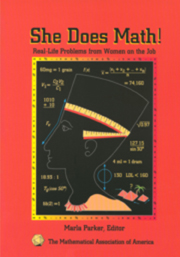Book contents
- Frontmatter
- Preface
- Contents
- Problems by Subject
- Environmental Psychology
- Software Engineering; Computer Science
- Archaeology
- Mathematics and Computer Science
- Civil Engineering
- Mathematics
- Electrical Engineering
- Physics; X-ray Astronomy Research
- Mathematics
- Physics; Astronaut Crew Training Instructor
- Business Data Processing
- Software Engineering; Real Estate Investment
- Quality Engineering
- Health Science
- Nursing Education
- Electrical Engineering; Space Systems
- Oil and Gas Accounting
- Business Administration Higher Education
- Aerospace Engineering
- Structural Engineering
- Computer Science
- Mathematics
- Dietetics—Foodservice Management and Nutrition
- Electrical Engineering
- Chemical Engineering, retired
- Software Engineering
- Immunology and Microbiology
- Mechanical Engineering
- HMO Pharmacy Practice and Management
- Ophthalmology
- Electrical Engineering
- Fish Pathology
- Computer Science and Computer Graphics
- Mathematics and Computing
- Electrical Engineering
- Astronomy
- Author
- Mathematics
- Reflections on WAM
- Solutions
Electrical Engineering
- Frontmatter
- Preface
- Contents
- Problems by Subject
- Environmental Psychology
- Software Engineering; Computer Science
- Archaeology
- Mathematics and Computer Science
- Civil Engineering
- Mathematics
- Electrical Engineering
- Physics; X-ray Astronomy Research
- Mathematics
- Physics; Astronaut Crew Training Instructor
- Business Data Processing
- Software Engineering; Real Estate Investment
- Quality Engineering
- Health Science
- Nursing Education
- Electrical Engineering; Space Systems
- Oil and Gas Accounting
- Business Administration Higher Education
- Aerospace Engineering
- Structural Engineering
- Computer Science
- Mathematics
- Dietetics—Foodservice Management and Nutrition
- Electrical Engineering
- Chemical Engineering, retired
- Software Engineering
- Immunology and Microbiology
- Mechanical Engineering
- HMO Pharmacy Practice and Management
- Ophthalmology
- Electrical Engineering
- Fish Pathology
- Computer Science and Computer Graphics
- Mathematics and Computing
- Electrical Engineering
- Astronomy
- Author
- Mathematics
- Reflections on WAM
- Solutions
Summary
The turning point of my lifelong mathematical awareness was in the sixth grade, when math became fun and interesting. My career plan was laid out in the ninth grade when I decided to become a math teacher, at that time the only job option I knew for people who liked math. Since becoming a math teacher meant taking a lot of math classes and going to college, my high school courses consisted of four years of math, science, and English, two years of Spanish, and of course the required social studies and P.E. classes, plus some music classes. This prepared me for almost any college while providing a well-rounded education.
Attending the University of California at Davis to pursue a mathematics degree, I plunged into calculus, chemistry, and physics. But by the end of my freshman year, mathematics, especially calculus, became too abstract for me. At this same time, I enrolled in an introduction to computer programming class for engineering students and enjoyed it. To my surprise, the engineering students in this computer programming class were also in my math, chemistry, and physics classes. So I took more engineering classes and discovered they were fun. Engineering, especially electrical engineering, uses even more applied math than math majors use. Now I could apply my math and science “tools” to something that felt closer to real life.
After receiving a Bachelor of Science in Electrical Engineering, I went to work for IBM, and have been there ever since.
- Type
- Chapter
- Information
- She Does Math!Real-Life Problems from Women on the Job, pp. 126 - 131Publisher: Mathematical Association of AmericaPrint publication year: 1995



